Poll: The empathy vote
Gauging the attitudes that drive Minnesota voters.
From soccer moms to NASCAR dads, from gray voters to Millennials — political experts have spent decades identifying certain voters by their demographic characteristics. Based on the results of the latest Thinking Minnesota Poll, it might be more useful to begin identifying people less by who they are and more by how they feel.
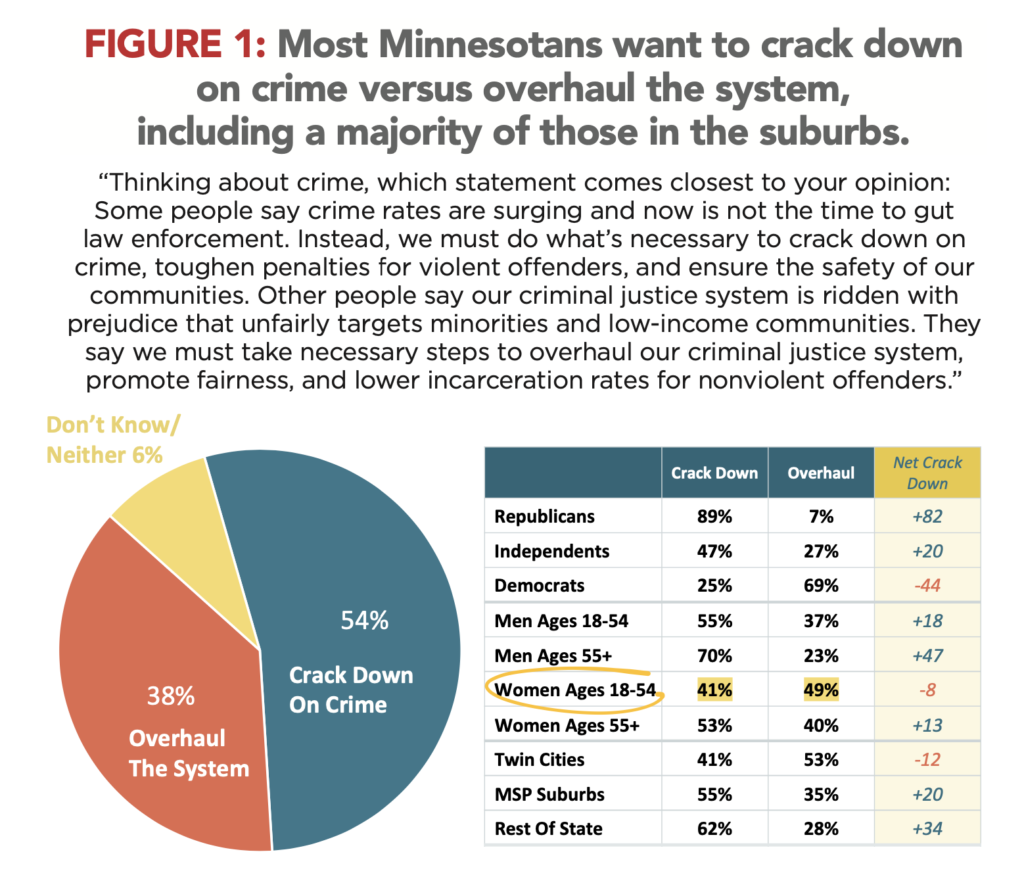
Soccer moms, for example, are typically thought of as highly educated women aged 18-54, mostly living in the suburbs. As we tracked that demographic throughout the questions in the poll, their answers revealed a common feeling: empathy. Repeatedly, these respondents chose solutions that went against their own best interests, with empathy for others the common denominator in their answers to questions on public safety, education, race, taxes, and energy policy.
Let’s call them political empaths.
Instead of worrying about their own safety, they feel empathy for minorities they see as being unfairly targeted in a prejudicial justice system. Instead of worrying about higher taxes for themselves (most of our political empaths have college degrees), they feel empathy for those who might need paid family leave. Again, instead of worrying about their own family budget, they push for more funding for K-12 schools, empathizing with teachers who they believe work hard for little pay.
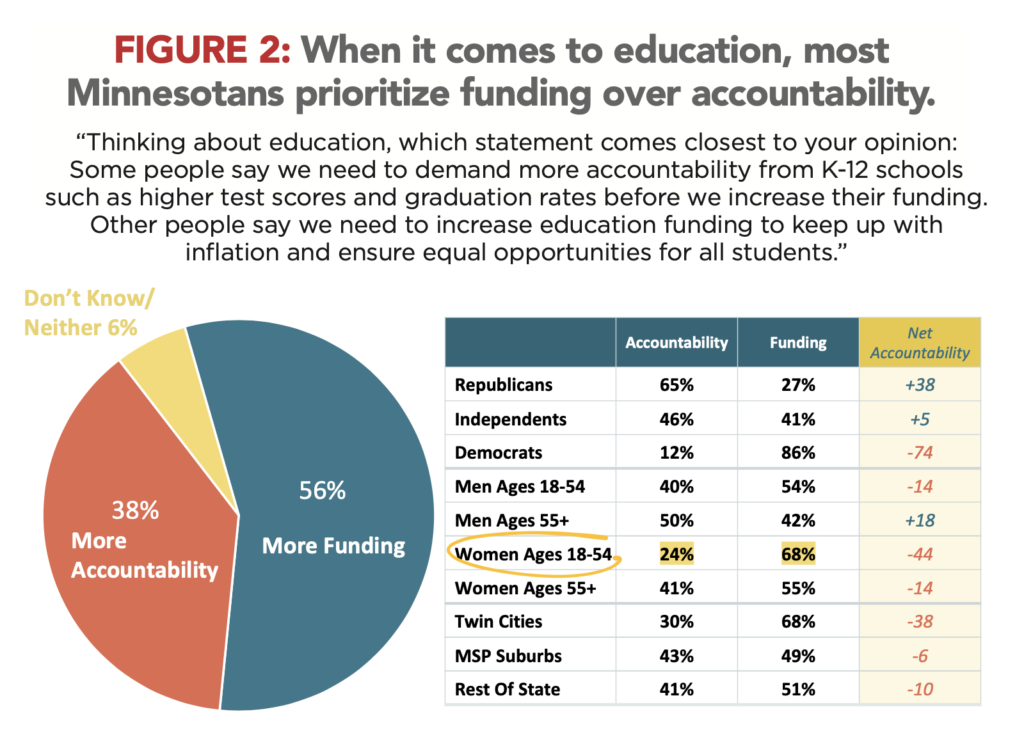
The fact that these empaths are believing myths promoted by political messaging (like teachers not being paid enough) is irrelevant for those in the business of trying to figure out how to make a sale, win an argument, or get elected to office. Feelings rule the day.
The Thinking Minnesota Poll was conducted by Meeting Street Insights, a nationally recognized polling operation based in Charleston, South Carolina. Using a mix of cell phones and landline phones, the company interviewed 500 registered voters across Minnesota from November 28-30, 2022. The margin of error is +-4.38 percent.

It starts with public safety. Given the choice between cracking down on crime and overhauling our criminal justice system, Minnesotans favored getting tough on crime 54 percent to 38 percent. But our political empaths (women 18-54) bucked that trend and chose overhauling the system 49 percent to 41 percent. That number stands out from every other age group and is 21 points different from women 55 and older. Instead of concern for their own personal safety, they are showing empathy for minorities stuck in a criminal justice system they believe is unfair.
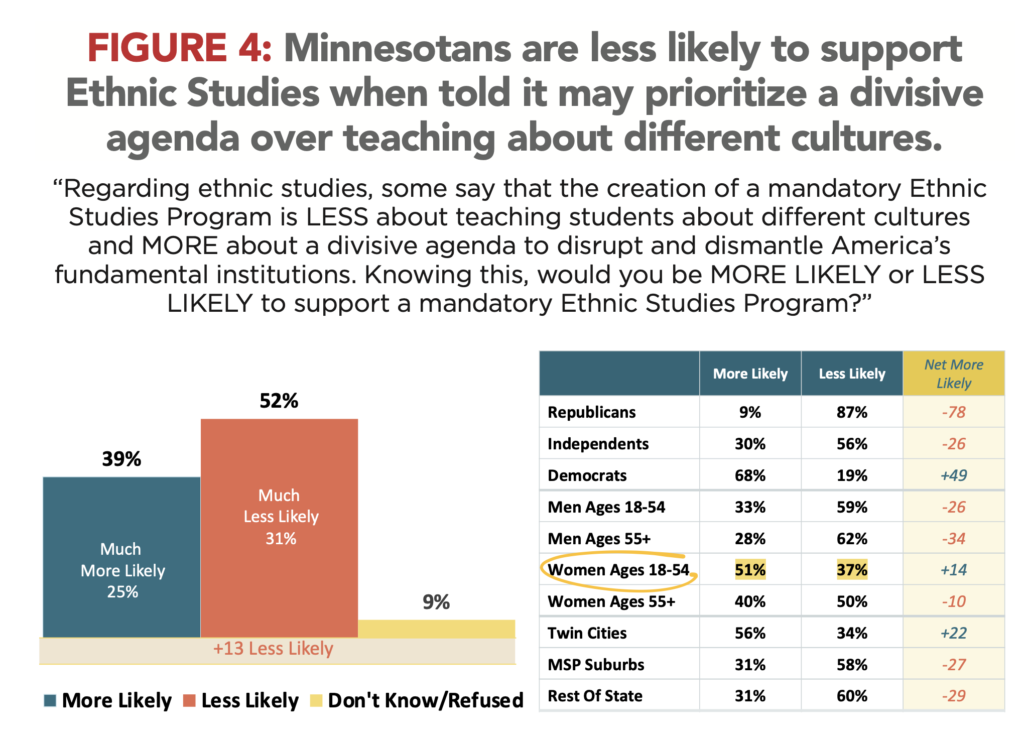
Our political empaths stood out again in a question pitting education funding versus more accountability, with 68 percent choosing increased education funding and only 24 percent demanding more accountability from K-12 schools before we increase their funding. This 44-point spread was by far the largest difference of any demographic subgroup. Part of that is empathy but there is undoubtedly some self-interest with this age group as many women aged 18-54 have children in the school system.
Ultimately, political empaths’ strong support for funding drove the overall result of the education question, with respondents favoring funding over accountability by 18 points, 56 percent to 38 percent. With a $17.6 billion state budget surplus, it will be hard to stop the momentum of throwing money at the K-12 education system even as the research shows it will do nothing to lift test scores that plummeted during the pandemic.
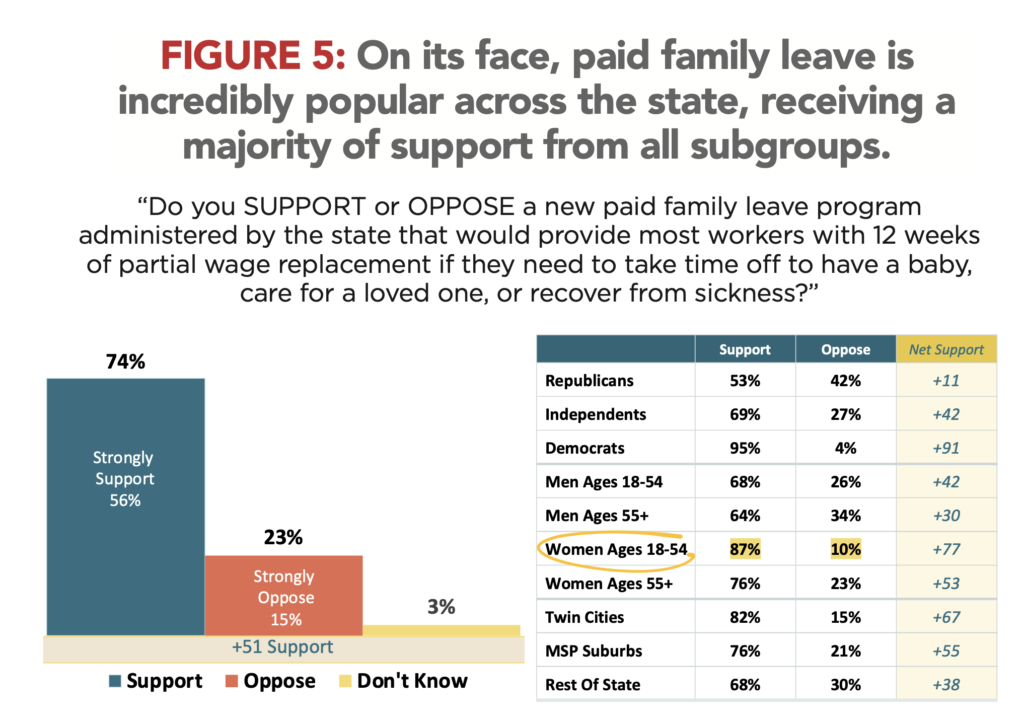
We asked respondents about injecting ethnic studies into the curriculum for all Minnesota students, including as a graduation requirement. A slight majority of Minnesotans (51 percent) favor the concept of ethnic studies while 37 percent oppose it and 11 percent remain unsure. But when given more information about the real agenda behind this innocuous sounding topic, opinions change to 39 percent/52 percent support/oppose. We characterized ethnic studies as less about teaching students about different cultures and more about a divisive agenda to disrupt and dismantle America’s fundamental institutions. All age and gender subgroups flipped their views once they were given this description, except for our political empaths.
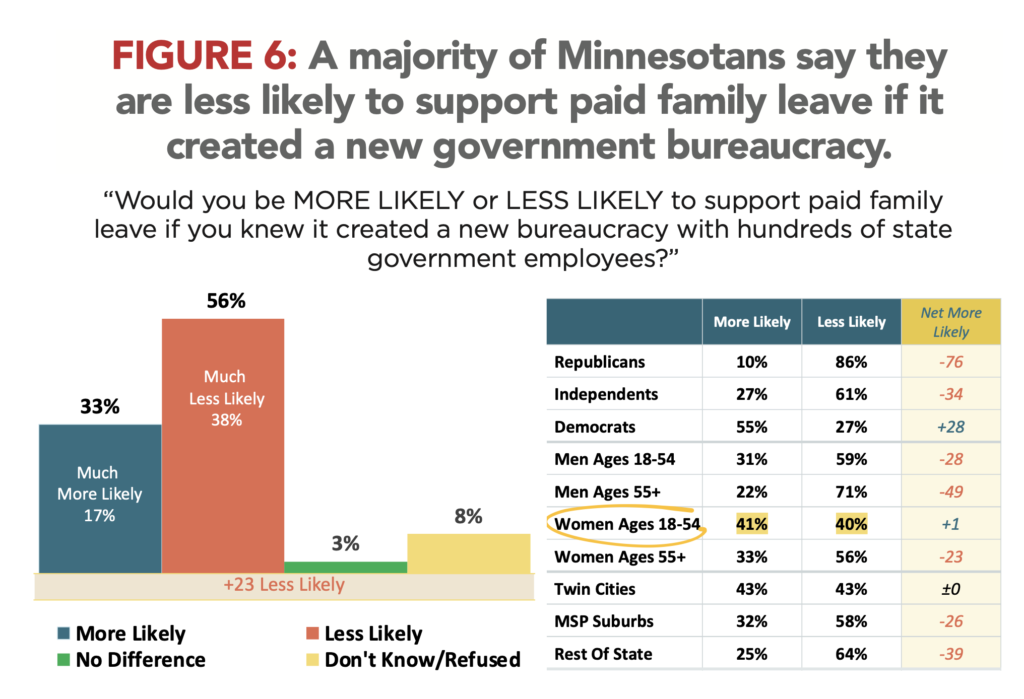
Women aged 18-54 actually doubled down on the concept with 51 percent of them saying they were more likely to support ethnic studies in schools once they learned about the true agenda. Again, self-interest does not explain this shift.
Another topic where our political empaths stood out was on the concept of paid family leave, something Gov. Tim Walz and the new Democratic legislative majorities are likely to move forward in 2023. Not surprisingly, the concept of paid family leave is very popular with Minnesotans with 74 percent favoring it and only 23 percent against. But the devil is in the details. Support falls when respondents learned paid leave proposals will require a new state government bureaucracy with hundreds of new employees. With that information, 56 percent were less likely to support it.

Support for family leave did not necessarily fall once respondents learned it would require a new payroll tax on every employer and every employee. In fact, 47 percent were more likely to support it with the tax and only 41 percent were less likely. Our political empaths drove this result with 57 percent of them saying they were more likely to support paid family leave if it included a tax.
Next, we asked respondents about their thoughts regarding the record setting state budget surplus. A strong plurality of Minnesotans preferred tax cuts over spending when asked how the legislature should use a projected budget surplus in 2023. Forty-six percent of respondents chose permanent tax cuts (27 percent) or a one-time tax rebate (19 percent) when asked what should be done with the surplus. The next most popular choice was fully funding education, and our political empaths led the way on this answer with 30 percent of the subgroup making this choice. Women 18-54 have little interest in cutting taxes with only 19 percent favoring a permanent tax cut and 9 percent favoring a one-time rebate, by far the lowest numbers of any subgroup.
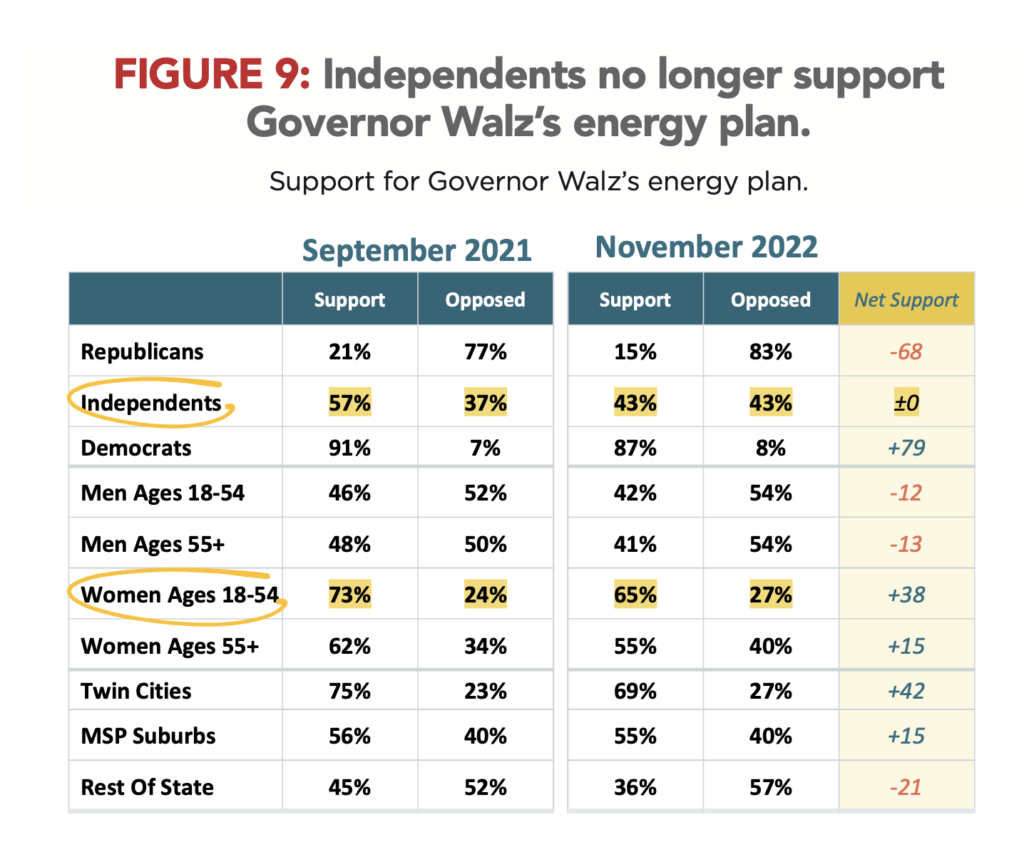
While support for Walz’s plan to convert Minnesota to 100 percent renewable energy has fallen significantly since last year, our political empaths remain strongly in favor. Support for the environment has always been a luxury for voters — when things are going well, Minnesotans care about climate change. When the economy is suffering, people care more about bread-and-butter issues. Only 51 percent of Minnesotans support Walz’s renewable energy mandate, down from 58 percent last year, with most of the erosion coming from political independents. True to form, our empaths still support the governor’s plan 65 percent to 27 percent.
In short, using traditional demographics to categorize voters is not as relevant as it once was, and political messaging can be a powerful tool in shaping attitudes and motivations underlying the issues. If the liberal agenda is to be countered this legislative session, conservatives need to meet voters where they are to change hearts and minds — and eventually votes.